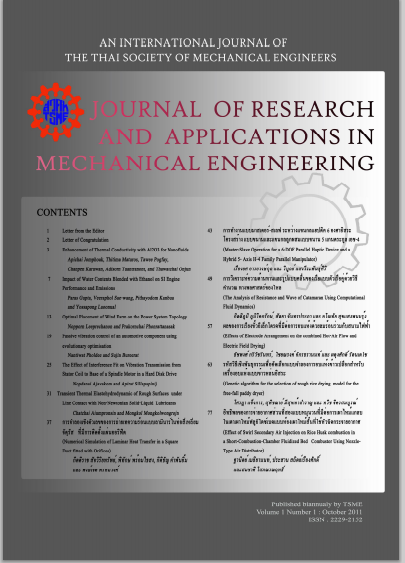Design of anti-bedsore hospital bed
Main Article Content
Abstract
An anti-bedsore bed is a medical device that prevents or delays occurrence of pressure ulcers by alleviating contact pressure exerted on a patient due to a contact with a bed. Normally a patient recovering in bed for an extended period of time will experience pressure ulceration due to insufficient blood flow to tissues in the areas that carry body weight. In this work, an extra bed setto be installed on a generic hospital bed has been designed to prevent pressure ulcers with a mechanism to change points of contact between body of patient and bed. The bed set consists of four sections for supporting a patient’s head, hip, thighs and heels. Changes in pressure on the patient’s body due to the movement of the bed set are measured by pressure films, and results are used in the assessment of the bed’s capability to prevent pressure ulcers by benchmarking with a risk curve for pressure ulcers in the literature. The test results confirm that the extra bed set can prevent pressure ulcers if the bed set operates at a 15-minute cycle.
Article Details
This work is licensed under a Creative Commons Attribution-NonCommercial-ShareAlike 4.0 International License.
References
[2] Samantha, B., Gordon, M.F., PhD. (2009). Reducing Pressure Ulcer Risk in The Operating Room, Allen Medical Systems, Acton, MA.
[3] สิทธิบัตรไทย“เตียงคนไข้ป้องกันการเกิดแผลกดทับที่ระดับคนไข้คงที่และพับยกหัวเตียงเอียงได้” 90,703 29 กรกฎาคม 2551. (Thai Patent “AntiBedsore Bed with Adjustable Back Support”, 90,703 July 29, 2551.)
[4] US Patent“Hospital Bed and Lifting and Turning Device” 3,302,219 Feb 7, 1967.
[5] US Patent“Apparatus for Lifting and Turning a Bed Patient” 3,506,985 Apr 21, 1970.
[6] US Patent“Apparatus for Turning a Person Confined to Bed” 4,502,169 Mar 5, 1985.
[7] US Patent“Apparatus for Turning a Patient in Bed” 5,673,443 Oct 7, 1997.
[8] US Patent“Patient Support Systems with Layered Fluid Support Mediums” 6,421,859 Jul 23, 2002.
[9] US Patent“Method and Apparatus for Supporting and for Supplying Therapy to a Patient” 5,983,429 Nov 16, 1999.
[10] US Patent“Hospital Bed with a Weight-distributing Lever System” 4,559,656 Dec 24, 1985.
[11] US Patent“Hospital Bed” 4,592,104 Jun 3, 1986. [12] Oomens, C.W.J., Loerakker, S. and Bader, D.L. (2010). The importance of internal strain as opposed to interface
pressure in the prevention of pressure related deep tissue injury, Journal of Tissue Viability, vol. 19, 2010, pp. 35-42.
[13] Daniel, R.K., Priest, D.L., Wheatley, D.C. (1981). Etiologic factors in pressure sores: an experimental model, Arch Phys Med Rehabil, vol. 62(10), 1981, pp. 492-8.
[14] Kosiak, M. (1959). Etiology and pathology of ischemic ulcers, Arch Phys Med Rehabil, 1959, pp. 62-9.
[15] Reswick, J.B., Rogers, J.E. (1976). In: Kenedi, R.M., Cowden, J.M., editors. Bedsore biomechanics, Baltimore, University Park Press, 1976, pp. 301-10.
[16] Kosiak, M. (1961). Etiology of decubitus ulcers, Arch Phys Med Rehabil, 1961, pp. 19-29.
[17] Dinsdale, S.M. (1973). Decubitus ulcers in swine: light and electron microscopy study of pathogenesis, Arch Phys Med Rehabil, vol. 54(2), 1973, pp. 51-6.
[18] Salcido, R., Donofrio, J.C., Fisher S.B., LeGrand, E.K., Carney, J.M., Schosser, R., et al. (1995). Evaluation of ibuprofen for pressure ulcer prevention: application of a rat
pressure ulcer model, Adv Wound Care, vol. 34, 1995, pp. 38-40.



